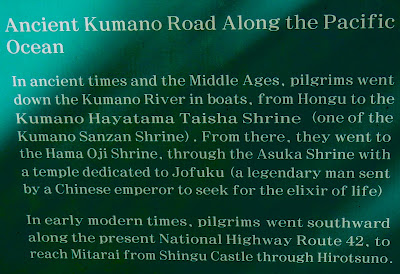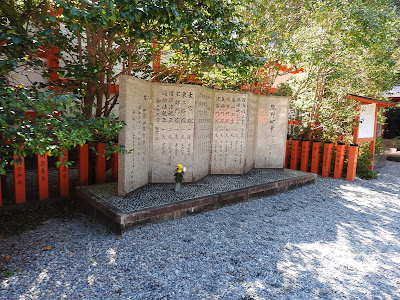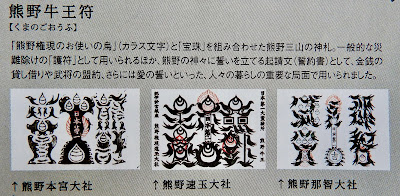 |
| 熊野・南紀旅行 11月12 - 14日 Kumano and Nanki Trip 12 -14th of November Kii Peninsula Trip |
 |
| 添乗員さん作成の予定表 実際の順番はいくつか変更になりました。 Schedule Created by Our Tour Conductor The actual order was changed. |
目次 / Contents
1) 熊野三山と熊野古道 / Kumano Sanzan and Kumano Kodō
2) たくさんの神々 / Many Gods
3) 新宮 / Shingū
A. 遷座 / Shrine Transferred
B. 磐座信仰 / Iwakura Belief
4) 熊野速玉大社 / Kumano Hayatama Taisha Shrine
A. 入り口 / Entrance
B. 社殿 / Buildings
C. 熊野牛王符 / Kumano-goōfu
5) 神社の木 / Trees in Shrine
A. 邪祓 / Exorcises Evil
B. 御神木 / Go-shinboku
6) 絵とき / E-toki
1) 熊野三山と熊野古道
Kumano Sanzan and Kumano Kodō
熊野三山 (クマノサンザン) は、
熊野本宮大社 (クマノホングウタイシャ)、
熊野那智大社 (クマノナチタイシャ)
熊野速玉大社 (クマノハヤタマタイシャ)
の3つの神社の総称です。
私達のツアーの熊野三山参拝の二番目は、
熊野速玉大社 (クマノハヤタマタイシャ)でした。
世界遺産 ・"紀伊山地の霊場と参詣道"と
吉野熊野国立公園 (ヨシノクマノコクリツコウエン)に指定されています。
 |
熊野古道 Map of Kumano Kodō : Map of the Old Roads of Kumano in Kii Peninsula, in Japanese ★ |
Kumano Sanzan and Kumano Kodō
Kumano Kodō are general term for pilgrimage approaches to "Kumano Sanzan".
The second of Kumano Sanzan visits on our tour was Kumano Hayatama Taisha Shrine.
This is registered as part of the World Cultural Heritage Site of the Sacred Sites and Pilgrimage Routes in the Kii Mountain Range and Yoshino-Kumano National Park.
那智滝については下記。 / About Nachi Falls, below.
那智大社については下記。 / About Nachi Taisha Shrine, below.
 |
| 速玉大社の案内板 Guide Map by Hayatama Taisha Shrine |
 |
| 速玉大社の説明板 下が切れてしまっていて、すみません。 ですが大体は理解できるかと....? Information board by Hayatama Taisha Shrine Sorry, only in Japanese, though the same content in English, below.  Information board by Hayatama Taisha Shrine |
 |
| 世界遺産碑 World Heritage Monument |
 |
| Red Circle ● : Sacred Sites and Pilgrimage Routes in the Kii Mountain Range 33°50′13″N 135°46′35″E 画像は下記より / This from below ★ |
2) たくさんの神々 / Many Gods
添乗員さんが、
「熊野三山の参拝では、熊野速玉大社が前世の罪を浄め、
那智大社が現世の縁を結び、
本宮大社が来世を救済するといわれていますが、
ツアーの都合で、今日は那智大社、速玉大社、本宮大社の順になります。本宮大社の前に船に乗ります」
と話していました。
熊野速玉大社のサイトでは、
'熊野速玉大社が「甦りの地」といわれる'
'熊野は生きる力を、もう一度受け取りに来るところなのです。'
と書いています。
熊野速玉大社には、壮大な力が備わっているような書き方です...
なので、たくさんの神の力が必要で、たくさんの神がここには祀られているのでしょう。
よく、違う神様のお守りを一緒にしてはいけないと言われますが、
ここでは、お守りどころか、複数の神様そのものを一緒にして祀ってるのです。
熊野三山はどこでも複数の神様を祀っています。
熊野の神様は、太っ腹で、小さなことを気にしないのですよね。
なので、私達のツアーの参拝順序が違っても、そんなこと、神様にとっては大した違いはないように思います。
主祭神は、熊野速玉大神(クマノハヤタマノオオカミ) :
伊邪那岐命(イザナギノミコト)と
熊野夫須美大神(クマノフスミノオオカミ) :
伊邪那美命 (イザナミノミコト)です。
二神は、国産みの夫婦神(元夫婦)であり、生と死の神です。
なるほど、'蘇りの地'と呼ばれるのもわかる気がします。
他の神々も祀っています。
(案内板にはイザナギ、イザナミを含めて13神が書かれています)
熊野は神仏習合の風土で、尚且つ同じ神社にたくさんの神々が祀られているのだな〜とあらためて思います。
神々が住う土地なんですね〜。
初めて気がつきました。
(オルペウスも禁忌を犯してその機会を逃します)
どの神話も、面白く、数多く共通点を持っているように感じます。
 |
たくさんの神様 案内板は左から右読みの古い形式で書かれています。 最近、あまり見ない書き方なので、新鮮! Many Gods The information board is written in the old format, reading from left to right. I haven't seen this writing style much recently, so for me, it's fresh! |
 |
| 国宝 National Treasure Left : Kumano Hayatama-no-Okami Statue Centre : Kumano Fusumino Okami Statue Right : Ketsukono Okami Statue 画像は下記より / This from below ★ |
Many Gods
Our tour conductor told us,
"In the worship of 'Kumano Sanzan',
it is said that Hayatama Taisha Shrine purifies the sins of the previous life, Nachi Taisha Shrine connects En : fate, destiny, a chance, relations, helping the present life,
and Hongū Taisha rescues the afterlife, the future,
but due to the convenience of the tour, today, our sequence is Nachi Taisha, Hayatama Taisha, and Hongū Taisha .
We will take a boat before Hongū Taisha."
On the Hayatama Taisha website (only in Japanese),
"Kumano Hayatama Taisha is said to be the "Land of Resurrection "
"Kumano is a place which people are about to come to receive the power to live again. "
(Translation by me)
Kumano Hayatama Taisha is written in such a way that it has magnificent power ... Yes, so it requires a lot of God power, and therefore many Gods are enshrined here.
In Japan, it is often said that amulets of different Gods should not be placed together, but here, not just amulets, but the Gods themselves are enshrined together.
All Kumano Sanzan enshrine multiple Gods.
The Gods of Kumano are generous and don't care about small things.
So, even if the order of worship on our tour is different, I don't think it makes a big difference for the Gods.
The main deities are Kumano Hayatama-no-Okami :
Izanagi (who is a creator deity (kami) in Japanese mythology) and
Kumano Hayatama-no-Okami :
The two Gods had been married, and they are Gods of life and death.
Indeed, I feel that here is also called the 'Land of Resurrection'.
Other Gods are also enshrined here as well.
(13 Gods including Izanagi and Izanami are listed on the information board)
I think again that Kumano has a culture of Shinbutsu-shūgō, furthermore many Gods are enshrined in the same shrines.
Here is the land where the Gods live, isn't it?
The God Married Couple is in Kuniumi (see an image below) which is the traditional and legendary history of the emergence of the Japanese archipelago, of the islands, in Japanese mythology.
One of their stories is that Izanagi went to bring his deceased wife, Izanami, back from Yomi which is the land of the dead.
He broke the conditions of her return and missed his opportunity.
For the first time, I realized that this was similar to the story of Orpheus entering the Netherworld in Greek mythology: trying to bring back his wife, Eurydice, who died after being bitten by a poisonous snake.
(Orpheus also broke the conditions of her return and missed his opportunity.)
Orphism, derived from Orpheus, is "the basic doctrine of dualism of soul and body, reincarnation, final liberation from reincarnation, etc." (from Japanese Wiki) , and I feel this is a similar idea to here, Hayatama Taisha Shrine, 'Land of Resurrection'.
I feel that all myths are interesting and have many common episodes.
 |
| 国産み 左:イザナミ / 右 : イザナギ 小林 永濯 (コバヤシエイタク/ 1843 -1890) 画 "天之瓊矛 (アメノヌボコ) を以 (モ) て滄海 (ソウカイ) を探るの図" Kuniumi Left : Izanami / Right : Izanagi By Kobayashi Eitaku (1843 -1890) "Izanami and Izanagi Creating the Japanese Islands" 画像は下記より / This from below ★ |
2) 新宮 / Shingū
A. 遷座 / Shrine Transferred
熊野速玉大社の別名は、'新宮' (シングウ)です。
その訳は、社伝によると、(下記、要約)
"速玉大社は、
景行天皇 (ケイコウテンノウ/ BC13 - AD134 / 在位:71- 134)
58年 (西暦128年頃)に、
現在の場所 [新宮市新宮(シングウウ)1]に、遷座 (センザ)し、
'新宮'と呼ばれます。"
1871年に、熊野速玉大社になります。
1883年に打ち上げ花火が原因で社殿が全焼、1967年に社殿が再建されました。
現在、神倉神社は、熊野速玉大社の摂社 (セッシャ)です。
実は私にとっては、神倉神社の方が興味深く思えます。
というのは、神倉神社は、岩を祭る自然信仰、磐座信仰 (イワクラシンコウ) だからです。
速玉大社の説明板 Information Board by Hayatama Taisha Shrine |
 |
| 熊野御幸の記録 天皇、太上天皇 (ダイジョウテンノウ; 退位した天皇)や 太上法皇 (ダイジョウホウオウ; 出家した天皇)、 貴族が京都から '熊野詣で' を熊野御幸 (クマノゴコウ)と 呼びます。 "Kumano-gokō" Record "Kumano-gokō" means visits by Royal family to Kumano Sanzan as pilgrims. |
Shrine Transferred
Another name for Hayatama Taisha Shrine is 'Shingū '; New Shrine.
According to Shrine's history, (Summary below)
"In the Emperor Keikō (traditional, BC13 - AD134 / reign : 71 - 134), 58 (c. AD128),
the Shrine was transferred to the present location
[Shingū 1 in Shingū City,Wakayama Prefecture]
from Mt. Kamikura (Kamikurayama, 120m)
[1-13-8, Kamikurayama, Shingū City, Wakayama Prefecture].
It is called Shingū '; New Shrine."
Kamikurayama became Kamikura Shrine, it is called 'Motomiya' ; Original Shrine."
In 1871, 'Shingū' became Kumano Hayatama Taisha Shrine.
The shrine was completely destroyed by fireworks in 1883, and the shrine was rebuilt in 1967.
Currently, Kamikura Shrine is a Sessya of Kumano Hayatama Taisha Shrine.
According to Wiki about Sessya,
"Sessha (摂社, auxiliary shrine) and massha (末社, undershrine),
also called eda-miya (枝宮, branch shrines)
(collectively known as setsumatsusha, 摂末社)
are small or miniature shrines entrusted to the care of a larger shrine, generally due to some deep connection with the enshrined kami."
To tell the truth, Kamikura Shrine seems more interesting to me than Hayatama Taisha Shrine.
This is because Kamikura Shrine is based on a natural belief that worships rocks, the Iwakura Shinkō: Iwakura Belief.
B. 磐座信仰 / Iwakura Belief
新宮市観光協会が発行している冊子がとても美しく、立派で驚きました。
新宮市の力の入れようが感じられます。
その冊子で、神倉神社や、神倉山のゴトビキ岩を知りました。
'ゴトビキ'は、ヒキガエルをあらわす新宮の方言だそうです。
神倉神社では、巨石、"ゴトビキ岩" がご神体として祀られています。
神倉神社は最初から速玉大社が世話をしてきたのではありません。
(当初から摂社ではありませんでした)
神倉神社は、他の神社や寺、時の権力者によって祀られてきました。
何せ、1800年以上の歴史ですから、そりゃもう、色々...ありました...。
1907年になって、ようやく速玉大社に合祀 (ゴウシ) されました。
(「熊野権現垂迹縁起」)
この説に従えば、熊野三所大神がどこよりも最初に降臨したのはこの地であり、そのことから熊野根本神蔵権現あるいは熊野速玉大社奥院と称された。"
'速玉' の意味は、最初に参拝する意味よりも、神様が最初に降臨したことにあったのだ!とようやく納得しました。
これは私が日本語 (古語?) をよく理解していないためかもしれません。
 |
| 綺麗な冊子 表紙は、神倉神社からの眺めの写真です。 Beautiful Booklet The cover is a photo of the view from Kamikura Shrine.  |
Iwakura Belief
The booklet published by the Shingu City Tourism Association was very beautiful and I was surprised.
In that booklet, I learned about Kamikura Shrine and Gotobiki Rock on Mt. Kamikura.
"Gotobiki" in the dialect of the Shingu area means True toad.
Kamikura Shrine was not always taken care of by Hayatama Taisha Shrine (it was not a Sessya of Hayatama Taisha Shrine from the beginning).
Kamikura Shrine had been enshrined by other shrines, temples, and people in power at the time.
After all, it has a history of more than 1,800 years, so there were many things and happenings...
In 1907, it was finally enshrined together with Hayatama Taisha Shrine.
The Wiki also has the following:
"When the Kumano faith became popular, it was said that Kumano Gongen was the first place to descend in Kumano after a nation's journey.
[from " Kumano Gongen Suijaku Engi" (1163 - 1164 / documents about Kumano)]
According to this theory, it was here that the Kumano Three Great Shrine Gods first descended, and for that reason it was called Kumano Original Gongen or Kumano Hayatama Taisha Inner Shrine. "
'Hayatama' means "The First Gods".
I was finally convinced that the meaning of 'Hayatama' was more about the descent of the Gods here, than the meaning of people worshiping here first!
It might be because I do not understand old Japanese enough.
 |
| 神倉神社 128年創建。 神倉神社の起源は、古神道 (コンシンドウ: ★) の 磐座信仰 (イワクラシンコウ)と言われています。 磐座とは、古神道における岩に対する信仰のこと。 あるいは、信仰の対象となる岩そのもののこと。 Kamikura Shrine Established in 128. The origin of Kamikura Shrine is said to be the Iwakura Shinko of Ko-Shintō which refers to the original animism of Jōmon period Japan which is the alleged basis of modern Shinto. Iwakura is a belief in rocks in Ko-Shintō. Or the rock itself, which is the object of worship.  A giant rock , "Gotobiki Rock", is enshrined as a God |
私は、旅行中にこの岩を知り、とても現地へ行ってみたくなりした。
個人旅行なら、計画変更も可能ですが、ツアーではそういうあけにもいかず実現できませんでした。
 |
| 御神体のゴトビキ岩と拝殿 Gotobiki Rock as Go-shintai, the God, and Hall of Worship 画像は下記より/ This from below ★ |
I found out about this rock while on this tour and was very eager to go there.
It is possible to change the plan for a private trip, but it was not possible to do so on the tour.
 |
| 参道・麓の鳥居 石段538段を登ると、参拝でき、 ゴトビキ岩も近くで見ることができます。 Torii at Foot of Approach Climb the 538 stone steps to worship and see Gotobiki Rock nearby. 画像は下記より / This from below ★ |
 |
| 上:熊野速玉大社と、下: 神倉神社 Top : Kumano Hayatama Taisha and Bottom : Kamikura Shrine (画像は冊子より/ The image from the Booklet)  説明板 / Information Board |
3) 熊野速玉大社
Kumano Hayatama Taisha Shrine
A. 入り口 / Entrance
 |
境内地図 神宝館は、'南紀州の正倉院' と呼ばれ 約1200点の国宝: ★が 保管・展示されているそうです。 (ツアーでは見る時間がありませんでした) Precinct Map |
 |
| 熊野御幸についての速玉大社の説明板 熊野神社には、諸宗教が混じっていると認識していましたが、 この案内板によって、陰陽師まで関係していると知り、 驚きました。 含まれていたことに気づき、陰陽師は、 陰陽五行説に基づいているのです。 私にとっては、'陰陽五行説'と言われるよりは、 '陰陽師'と言われた方が、ピン!ときたということですね。 by Hayatama Taisha Shrine I knew that Kumano Shrines are a mixture of religions, but I found out from this information board that I was a little surprised. Oh! Yes! I realized Kumano's Shinbutsu-shūgō included the Ying-Yang Five Elements theory, and Onmyōdō is based on Inyo Gogyo Shiso : [Shinbutsu-shūgō ("syncretism of kami and buddhas"), also called Shinbutsu-konkō is the syncretism of Shinto and Buddhism that is Japan's only combined religion.] For me, it was click with "Onmyōji", rather than to say "Ying-Yang Five Elements"! |
熊野御幸 については下記のセクションで書いています。
I wrote about Kumano-gokō in the section below.
B. 社殿 / Buildings
 |
| 左:神門 / 右:手水舎 Left : Kamimon / Right : Chozuya Chōzu-ya or temizu-ya is a Shinto water ablution pavilion for a ceremonial purification rite. |
 |
拝殿 / Haiden ; Worship Hall  注連縄 / Shimenawa Shimenawa ('enclosing rope') are lengths of laid rice straw or hemp rope used for ritual purification in the Shinto religion. |
 |
| 左 : 拝殿 / 右 : 上三殿 Left : Haiden / Right : Kamisanden Hall |
 |
| 千木 (外削ぎ) 千木 (チギ) の風穴がハート型になっていることに驚きを感じます。 Chigi (Vertically Cut) Chigi are ornamental crossed rafter ends on shrine gables. I am surprised that Chigi's wind holes are heart-shaped. |
C. 熊野牛王符 / Kumano-goōfu
 |
| 熊野牛王符 熊野牛王符 (クマノゴオウフ) は、熊野三山で配布される 特別な神札 (シンサツ)で、 八咫烏 (ヤタガラス) がデザインされています。 Kumano-goōfu ; Kumano Amulet Kumano-goōfu ; Kumano Amulets are distributed Left:Kumano Hongū Taisha Shrine, Centre : Kumano Hayatama Taisha Shrine Right : Kumano Nachi Taisha Shrine |
牛王符は、護符として以外に、誓約書としても利用されました。
牛王符の裏面に起請文を書きます。
こうすると誓約の内容を熊野権現に対して誓ったことになりました。
誓約を破ると熊野権現の使いであるカラスが一羽(一説に三羽)死に、約束を破った本人も血を吐いて死に、地獄に落ちると信じられました。
豊臣秀吉 (1537 - 1598) が諸国大名との誓約に、速玉大社の熊野牛王符を使用したと言われています。
 |
| 熊野速玉大社の熊野牛王符 戦国時時代 (1467 -1590) から、この同じデザインが 使用されています。 Kumano Hayatama Taisha Shrine's Kumano-goōfu This same design has been used since Sengoku Period ; the Warring States Period (1467 - 1590). 画像は下記より / This from below ★ |
Goōfu was used not only as an amulet but also as a written pledge.
Write a letter of invocation on the back of Goōfu.
By doing this, the contents of the pledge were sworn to Kumano Gongen : Kumano Gods.
["A gongen, literally "incarnation", was believed to be the manifestation of a buddha in the form of kami, an entity who had come to guide the people to salvation, during the era of shinbutsu-shūgō in premodern Japan. ~~~
People believed if the pledge was broken, one crow (three in one theory) who was the messenger of Kumano Gongen, would die and the person who broke the promise would also die by spitting blood, and fall into hell.
It is said that Toyotomi Hideyoshi (1537 - 1598) used the Kumano Hayatama Shrine's Goōfu in his pledge with Daimyo ; Local King of each country.
4) 神社の木 / Trees in Shrine
A. 邪祓 / Exorcises Evil
 |
| 献木・ジャバラ / (邪祓) Donation Tree ・Jabara They say Jabara means Exorcises Evil in Japanese.  According to Wiki about this, "Jabara (Citrus jabara / Tanaka) refers to a plant and fruit that is among the Japanese citrus. Jabara is a fruit similar to the yuzu, deriving (Citrus nobilis, but distinct from King), that arose naturally in Wakayama Prefecture" |
B. 御神木 / Go-shinboku
ナギは、'凪' と同音であることから、平穏無事の象徴でもあり、熊野詣の際、道中の安全を願い、この葉を懐中に納めてお参りすることが習わしとされています。
また、熊野詣後に '安らぎ' を求めた人々がその葉をいただいてきたとも言われています。
また葉脈が縦方向のみにあるため、強くちぎれないことから、絆を結ぶ木として、夫婦円満や縁結びのお守りとしても知らているそうです。
香川県の山地 義一 (当時64歳) 氏は、御神木のナギの種から苗木500本を育てました。
熊野速玉大社では、梛の木を「世界平和の木」にする運動を行なっています。
 |
| 樹齢千年・御神木のナギ (天然記念物) 公式サイト: ★ ナギはマキ科の常緑高木です。 Go-shinboku Nagi, 1000 Years Old Go-shinboku : God Tree (Natural monument) Nageia Nagi is plant species in the family Podocarpaceae and an evergreen tree. |
Go-shinboku
Go-shinboku Nagi is said to have been hand-planted by Taira no Shigemori (1138 - 1179), and boasts the largest height in Japan with a height of 18m and a trunk circumference of about 6m.
Since Nagi has the same sound as 'nagi' : calm, the Nagi is also a symbol of calm and safety, and it is customary for pilgrims to put some leaves in their pocket when on 'Kumano Pilgrimage', hoping for safety along the way.
Also, since the veins are only in the vertical direction, it cannot be torn off strongly, so it is known as a tree that connects bonds and as a talisman for married couples and marriage.
Mr. Yoshikazu Yamaji (64 years old at that time) in Kagawa Prefecture raised 500 seedlings from the seeds of the Nagi.
In 1973, the year after Okinawa's return to the mainland, Mr. Yamaji planted the seedlings at a school in Okinawa Prefecture to commemorate the restoration of the mainland.
Hayatama Taisha Shrine is campaigning to turn the Nagi tree into a "Tree of World Peace."
6) 絵とき / E-toki
 |
| 曼陀羅 曼荼羅(マンダラ)の絵を見つけて、ちょっとびっくり! この神社では、昔、熊野比丘尼(クマノビクニ)が 全国を巡り、熊野信仰を説いて歩いたという 『熊野観心十界曼荼羅 (クマノカンシンジュッカイマンダラ)』の 絵ときをしているようです: ★。 比丘尼というのは、変相図を含む説話画等の仏教絵画を 絵とき(物語る)する尼僧のことです。 熊野比丘尼は、絵ときをしながら、熊野牛王符を配ったそうです。 Mandala I was a little surprised to find a picture of Mandala! At this shrine, in the olden days, Kumano Bikuni traveled all over the country and preached the Kumano faith with E-toki Bikuni was a nun who did E-toki which explains about Buddhist paintings. It is said that Kumano Bikuni handed out Kumano-goōfu while doing E-toki. |
According to Wiki about E-toki,
"E-toki "picture deciphering, picture explaining") refers to a Japanese Buddhist practice of using an emaki (hand picture, a painted hand scroll) or picture halls (rooms with pictures either painted onto the walls, or containing a series of hanging scrolls) to explain a Buddhist principle."
おまけ/ Extra
 |
| 青いポスト 神社の脇の道で、古い型の青いポストを初めて見ました。 この型で赤ならば、鎌倉でも見かけますし、 我が家から最も近いポストもこの型の赤いポストです。 実際にこのポストが使用されているのかはわかりません。 Blue Postbox I saw an old blue mailbox for the first time on the road beside the shrine. I can see red ones of this type in Kamakura, and the postbox closest to my house is also a red one of this type. I don't know if this blue one is actually used.  和歌山では新しい型でも青いポストがあるそうです。 それらは、1990年に大阪であった '国際花と緑の博覧会'の会場に 設置されていた9つのポストです。 青は空をイメージしているそうです。 In Wakayama, even some of the new type of postbox are blue. There were 9 at the venue of in Osaka in 1990. Blue seems to be the image of the sky. |








0 件のコメント:
コメントを投稿